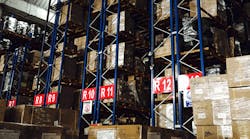If you own a business, you well may own a warehouse full of different kinds of racking. How can you be sure it’s all safe?
Entrepreneurs are told that the two most important things for any business are the product and the pitch, and this is true. However, racking safety is a stark reality for any business and it is something that requires every business owner’s attention. So here are some top tips for racking safety.
Know Your Racking
Different types of racking offer different storage solutions for different businesses.
Sometimes, the most expensive kind of of racking is not necessarily the safest. For example, a large floor stacking system will offer plenty of space and will be able to take a lot of weight, but it also uses up a lot of floor space. If your warehouse is too small, then a floor stacking system will end up making your warehouse less safe, no matter how good the quality is.
Selective pallet racking, by contrast, is less expensive and takes up less floorspace, but it stores much less. Choosing the type of racking you want for your warehouse requires as much planning as any other part of your business.
Private and Public Sector Racking Inspections
Warehouse and racking inspections are a matter of the public and private sector coming together in the name of safety, which means knowing your acronyms. In the United States,
OSHA might conduct an inspection of your warehouse as well as recommend expert inspections of your warehouse by private enterprises. Businesses can avoid surprise inspections by OSHA by being recognized as part of the SHARP program (OSHA’s Safety and Health Achievement Recognition Program).
The sometimes-confusing use of acronyms within the public and private safety world also occurs in the UK. There, the government department for health and safety (HSE) recommend that businesses get a SARI (SEMA-approved rack inspector) to help with the installation, maintenance and repair of its racking.
Wherever your business is based, there are a lot of acronyms, private firms and public organizations to learn. Still, knowing them is important if you want your racking to be as safe and as legal as possible.
Racking Inspection Training
By participating in SHARP, businesses “may receive an exemption from programmed inspections,” yet this is not an excuse to get careless. Rather, if your employees are trained enough in your safety standards that the government takes a step back, that is a great opportunity to take racking inspection into your own hands.
Create a logbook and a business-wide code of racking safety. For example, a system of green alerts, yellow alerts and red alerts is a great way to keep racking inspection simple enough for all employees to understand.
Remember though, consistency is key: There can be no grey areas when it comes to racking safety. Decide well ahead of time what your business considers to be a yellow alert and what your business considers to be a red alert. Racking safety is not like poetry class; there is no room for interpretation.
About the Author Justin O’Sullivan is a writer, safety expert and businessman. As the founder of SEMA Racking Inspections, he specializes in SEMA-approved racking inspections and racking inspection training courses.
